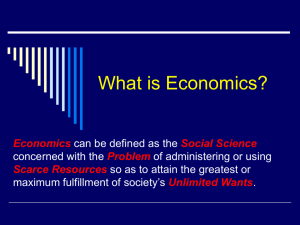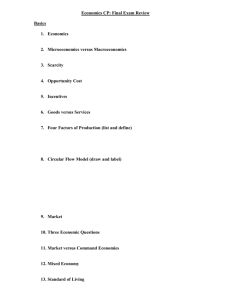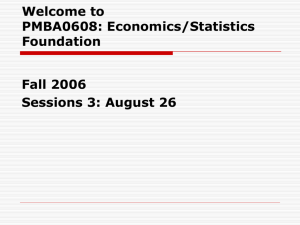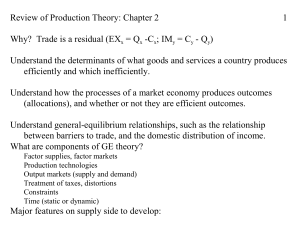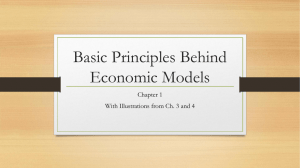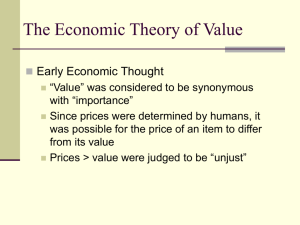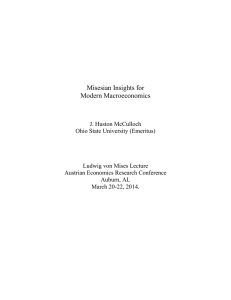Review of Production Theory: Chapter 2 1 Why?
advertisement
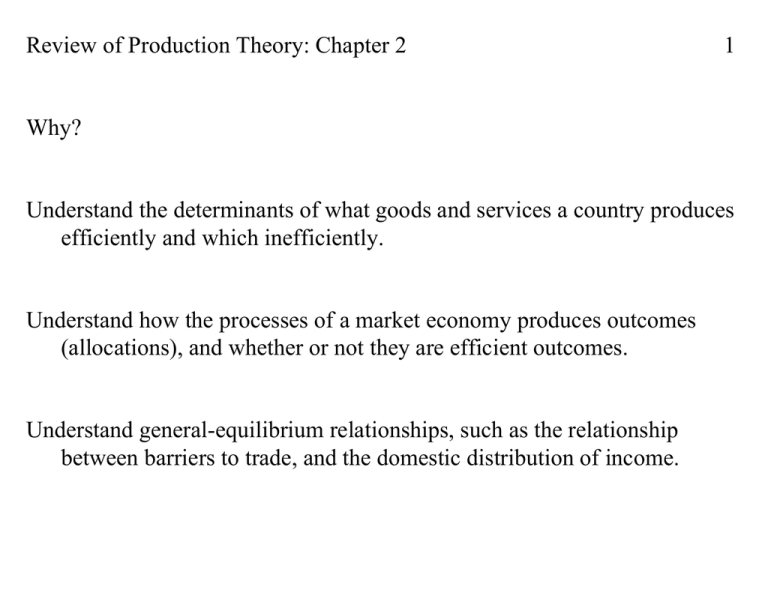
Review of Production Theory: Chapter 2 1 Why? Understand the determinants of what goods and services a country produces efficiently and which inefficiently. Understand how the processes of a market economy produces outcomes (allocations), and whether or not they are efficient outcomes. Understand general-equilibrium relationships, such as the relationship between barriers to trade, and the domestic distribution of income. 1. The production possibility frontier Position: (1) factor endowments (2) real factor productivities Slope: (1) relative factor productivities (2) factor endowments Curvature: (1) constant returns to scale (2) factor intensity effects (3) increasing returns to scale 2. Equilibrium for a single competitive producer Value of marginal product = factor price 2 3. The Edgeworth Box 3 Contract curve, efficient allocations Contract curve maps into PPF Competitive equilibrium implies production efficiency (production point is on the PPF) 4. Competitive equilibrium Establish that a competitive equilibrium is a tangency between the PPF and equilibrium prices. Properties of production functions (A) 4 Total factor productivity " is a “neutral” productivity parameter (B) (2.1) Returns to scale (i) Constant returns to scale (ii) Increasing returns I (iii) Increasing returns II (2.2) Figure 2.1 X Figure 2.2 X (ii) IRS (iii) IRS due to fixed costs (i) CRS O O V FC V 5 (C) Factor substitution and diminishing marginal product. (i) Straight line (perfect substitutes) (ii) Right angle (perfect complements) (iii) Smooth Curve (Cobb-Douglas) (2.3) (D) Marginal rate of substitution (2.4) (2.5) Figure 2.3 Figure 2.4 V2 V2 V22 V21 (ii) (iii) X2 X1 w1 w2 V12 V11 V1 (i) V1 Equilibrium for a single producer 6 (2.8) (2.9) (2.10) (2.11) (E) Factor intensity 7 at Y industry 2 is factor 2 intensive (2.12) suppose both goods have Cobb-Douglas technologies as in (2.3) above, but with different values of $ and specifically $1> $2. (2.13) The production set and the production possibilities frontier (ppf) (A) 8 Total factor productivity: absolute and relative. One factor of production and constant returns to scale in both of two industries. The single factor is in fixed supply and 2 in the amounts V1 and V2. and is allocated between sectors 1 (2.14) slope of ppf is a constant Figure 2.5 Figure 2.6 X2 X2 2V slope 2 1 A 1V X1 X1 (B) Increasing returns to scale I: 9 (2.15) (2.16) production frontier in convex (“bowed in”) (C) Increasing returns to scale II (IRS due to fixed costs 10 (2.17) The production frontier is “kinked”: segment with both goods produced is linear. But in a crucial way it has the same property as the “smooth” case. Any point on a line connecting the two endpoints is NOT a feasible production point. There is an efficiency cost to producing both goods. Figure 2.7 X2 Figure 2.8 X2 X 2 V FC F2 (V , K 2 ) FC A X 1 V FC F1 (V , K 1 ) X1 FC X1 (D) Factor intensities I: specific factors. Constant returns to scale Convex by diminishing MP 11 (2.18) (“bowed out”) (E) Factor intensities II: Heckscher-Ohlin. Constant returns to scale (2.19) Figure 2.9 Figure 2.10 O2 X 10 X 20 X2 B X 11 A V2 C X 21 O1 V1 A C B X1 Efficiency of competitive equilibrium I 12 First-order conditions for profit maximization (2.20) The first implication of these condition is factor market allocation efficiency. If we divide the first equation in each row of (2.20) by the second, we see that (2.21) The fact that the MRS in each industry is equal tells us that the competitive outcome must be on the contract curve in Figure 2.9 => on ppf. 13 Second, we can differentiate the production function for each good, and replace the physical marginal products Fij with wj/pi from (2.20). (2.22) The summations over the factors on the right-hand side are simply one subtracted from the tangency of ppf and price ratio (2.23) Figure 2.11 Figure 2.12 X2 X2 competitive equlibrium competitive equlibrium p0 p0 p0 X1 p X1 Efficiency of competitive equilibrium II (revealed preference) 14 Suppose that we observed that the output vector X0 , and the input matrix V0 are chosen at commodity and factor prices p0, w0. Suppose that X1 , V1 is any alternative feasible production plan. For each industry i, profit maximization implies that (2.24) If competitive producers are optimizing, the actual output and inputs chosen must yield profits which are greater than or equal to the profits obtained from any other feasible production plan. Sum over all i (2.25) Suppose that endowments are fixed at . For each factor j 15 (2.26) Thus the summation terms on the two sides of (2.24) cancel out. Therefore, the outputs X0 chosen at prices p0 maximize the value of production at those prices: (2.24) becomes (2.27) Geometrically, all feasible production points such as X1 must lie on or below the price hyperplane p0 through the actual production point X0. The price plane is “supporting” to the production set. What should you know? 16 (1) How the slope of c country’s production frontier depends on its technology and its factor endowments (2) How the curvature of the production frontier depends on (a) factor endowments (b) returns to scale (3) At given prices, undistorted competitive economies produce efficiently. this depends on: (a) (b) (c) (d) competition in all markets all firms face the same, true factor prices all firms face the same true output prices no externalities

